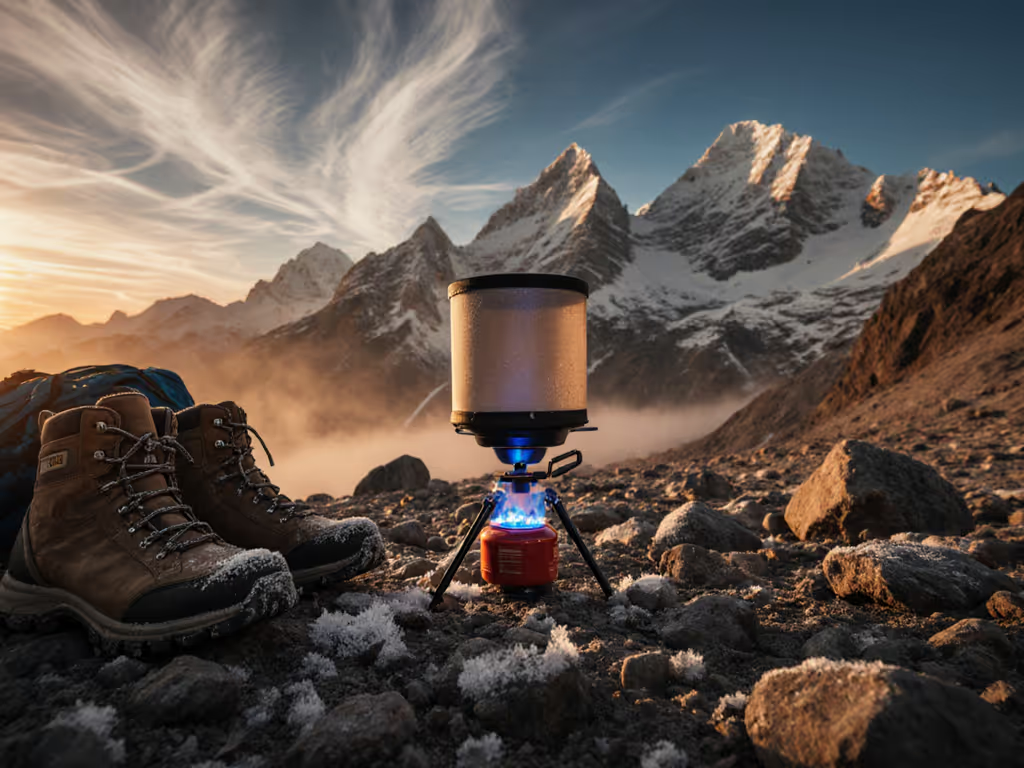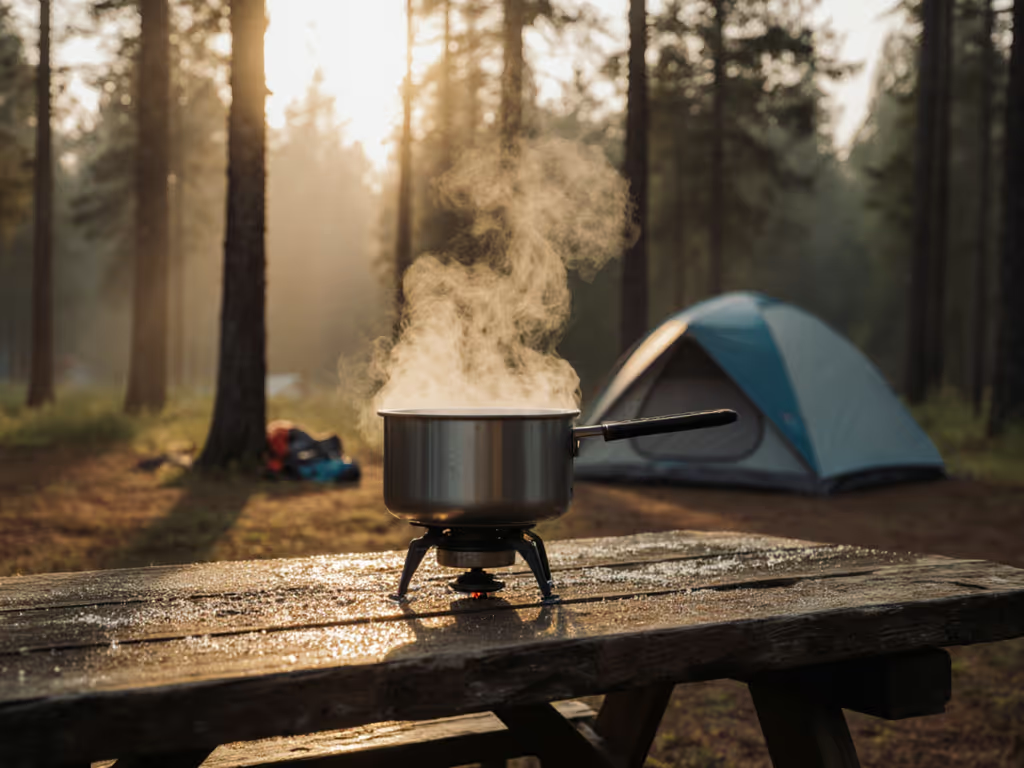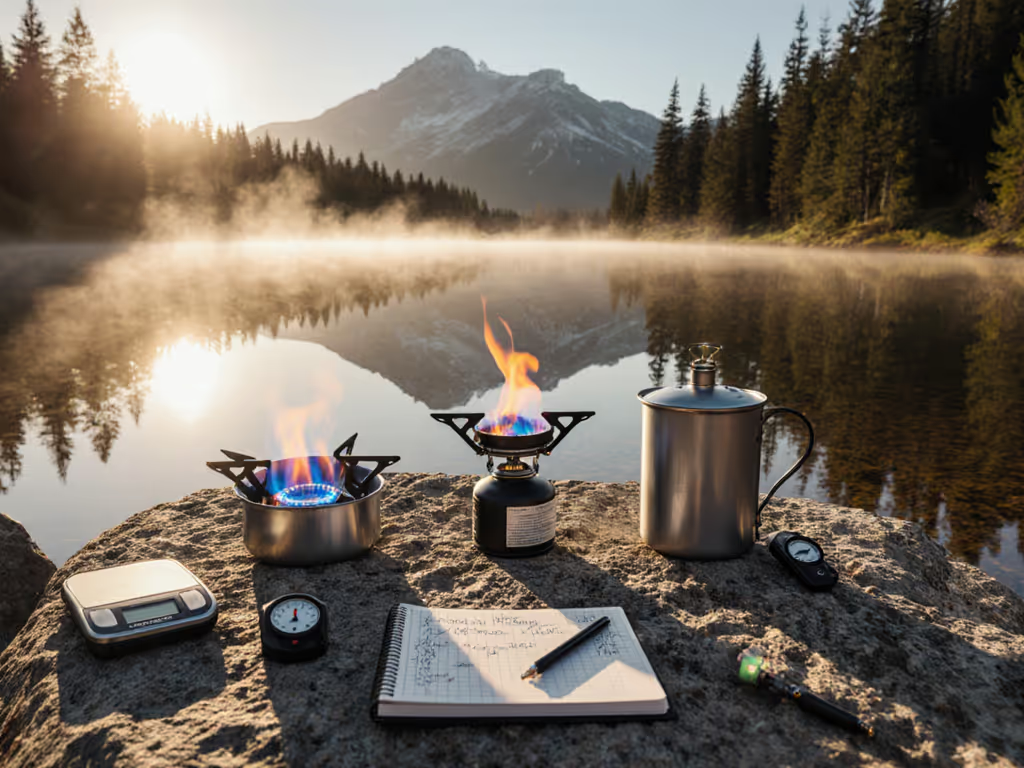
The Ultimate Guide to Stove Fuel Efficiency in Extreme Conditions: What Every Camper Needs to Know

If you have ever watched a full canister sputter or a pot take forever to boil on a ridgeline, you already know that stove fuel efficiency can make or break a trip, especially when temperatures plunge, winds rise, and you are cooking above treeline where air is thin and unforgiving. Efficiency is not just about saving grams of fuel but about reliability, safety, and the confidence that breakfast will actually happen when a storm is breathing down your tent walls, and the margin for error feels razor thin. In this guide, you will learn how temperature, wind, and elevation reshape the way fuels behave, how stove and pot designs either preserve or waste heat, and how to plan realistic fuel budgets for snow melting and real meals rather than only instant noodles. Along the way, you will see how Heatinerary and the Trip-Tuned Stove Lab bring personalized gear matching and recommendations tailored to your route profile and season so you can choose a setup that simply works where you are going, not just in a living room test.
Why Efficiency Plummets in Cold, Wind, and Altitude
Cold reduces the pressure in gas canisters, slows vaporization, and can push butane blends below the point where they can even feed your burner, while liquid fuels remain pump-driven but become thicker and harder to atomize until the stove warms the generator tube, which is why some stoves roar for a minute before settling down. Wind strips heat from pots and burners through convection and forces flames off the pot base, which increases boil times dramatically and can double fuel use if a pot is narrow and unshielded, so a simple, safe windscreen and a wider pot can feel like free energy. Elevation lowers the boiling point of water by roughly one degree Celsius for every three hundred meters, meaning water boils sooner but at a lower temperature, which shortens some boil times yet lengthens real cooking times for simmered foods, and that paradox catches many campers by surprise. For high-elevation cooking strategies and boil-time data, see our mountain stove testing guide. Think of it like hiking on marbles instead of gravel: the foundation of the heating process changes under your feet, and without adjusting gear and technique, you slide toward long boils, half-cooked meals, and fast-draining fuel bottles.
Choosing Fuels for Subzero Performance
Not all fuels are equal when the thermometer drops, because each has a different energy content, vapor behavior, and logistics footprint, and the differences become striking around freezing and become mission-critical below ten degrees Celsius. Propane stays gassy in serious cold and delivers strong pressure, but pure propane canisters are heavier and less common in backpacking formats, whereas mixed canisters lean on isobutane for better cold performance than plain butane but still sag below roughly twelve degrees Celsius unless warmed or inverted in a compatible remote-canister stove; white gas, often called naphtha camp fuel, thrives in the cold when properly primed and is the standard for snow-melting expeditions where liters of water are needed daily. For a deeper comparison of cold-weather fuels, check our propane vs butane vs white gas analysis. Alcohol and solid tablets are wonderfully simple and quiet, yet they have much lower energy content and suffer badly in wind and cold, which makes them better for shoulder seasons and minimalist cooking rather than for a week of subzero stew simmering, and that distinction matters when you are building a realistic plan rather than a wish.
Watch This Helpful Video
To help you better understand stove fuel efficiency, we've included this informative video from University of California. It provides valuable insights and visual demonstrations that complement the written content.
Fuel Options for Cold Weather and Their Practical Traits
| Fuel Type | Cold Performance Threshold | Approximate Energy Content per 100 grams | Vapor or Flow Behavior in Cold | Field Notes |
|---|---|---|---|---|
| Propane | Reliable well below minus twenty degrees Celsius | About five megajoules | Remains gaseous with strong pressure in deep cold | Great power but heavier containers; limited backpacking formats |
| Isobutane Blend | Workable down to around minus twelve degrees Celsius | About four point nine megajoules | Pressure drops as canister cools; improves with inversion on compatible stoves | Versatile and common; manage temperature and use windshields with care |
| Butane | Struggles near zero degrees Celsius | About four point nine megajoules | Poor vaporization in cold; often unusable below freezing | Better for warm seasons and car camping with protective sleeves |
| White Gas (naphtha camp fuel) | Reliable far below minus twenty degrees Celsius | About four point six megajoules | Pump-driven delivery; requires priming and good maintenance | Expedition standard for snow melting and large meal volumes |
| Alcohol (ethanol or methanol based) | Best above five degrees Celsius | About three megajoules | Low flame temperature and wind sensitivity | Minimalist, quiet, but slow and inefficient in wind or cold |
| Solid Fuel (hexamine) | Usable in many conditions with careful wind protection | About three megajoules | Steady but low heat, difficult to adjust | Emergency-only or ultralight backup for hot drinks |
From a planning perspective, mixed canisters paired with remote-canister stoves that allow safe canister inversion strike a strong balance for cold shoulder seasons, while true winter work leans toward white gas for stable output and easy refueling logistics in remote areas where you can carry extra in a lightweight bottle rather than haul many metal canisters. A strategy that many cold-weather travelers use is to start with a canister system for the first days when temperatures are milder and then switch to white gas as the route climbs and the forecast darkens, which spreads weight and preserves convenience when you want it most, and Heatinerary’s Trip-Tuned Stove Lab can recommend that blend based on your route profile and seasonal temperature expectations. Remember also the small tricks that pay big dividends: keeping canisters in your jacket during the day, using a small cup of warm water to gently temper a canister before use, and packing a stove tool and spare pump parts if you are bringing a liquid-fuel workhorse that deserves a little care. With those choices and habits aligned, you step into camp with confidence rather than a hope that a blue flame appears.
Stove Designs That Maximize Stove Fuel Efficiency
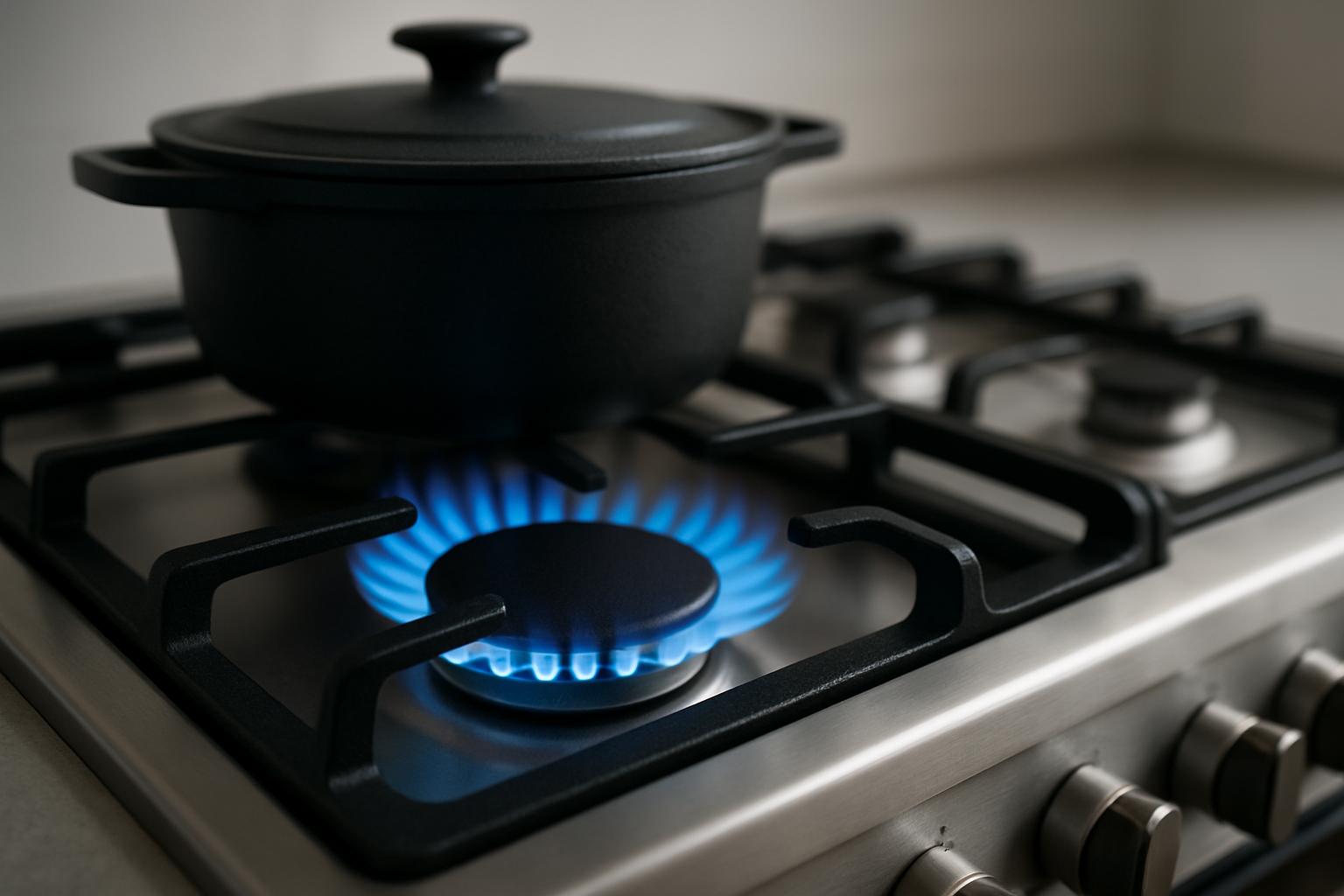
Stove architecture determines how well a flame couples with your pot, how much heat escapes to the wind, and how gracefully you can simmer without wasting energy, and the design choice matters more as conditions worsen because sloppiness compounds at altitude and in gusts. Upright canister stoves win on simplicity and speed, yet their small burners and exposed flames lose massive heat in wind, while integrated canister systems use heat-exchanger pots and partial shrouds to funnel more energy into the water, often cutting boil fuel use by thirty to fifty percent in fair weather, though they require careful wind management to avoid overheating canisters. Still choosing between platforms? Start with our canister vs liquid-fuel guide to match technology to your conditions. Remote-canister stoves with a preheat tube let you invert the canister to feed liquid fuel to the burner in cold, boosting output and stability, and white gas stoves with generator tubes are the tank-like classics that, when tuned and paired with a real windscreen, deliver reliable heat for large pots and snow-melting marathons. Beyond power, pay attention to supports wide enough for your cookware, regulators that allow precise flame control to reduce boil-over waste, and maintenance needs that you can actually meet in the field so efficiency improves rather than fades as jets clog and seals dry out.
Stove Types and Real-World Efficiency Traits
| Stove Type | Wind Handling | Simmer Control | Cold Performance | Best Use |
|---|---|---|---|---|
| Upright Canister | Poor without a natural windbreak | Good to very good on regulated models | Fair with isobutane, weak below freezing | Fast solo boils in mild to moderate weather |
| Integrated Canister System | Moderate with partial wind protection | Limited simmer but very fast boils | Fair; can overheat canister if screened incorrectly | Boil-focused trips, coffee and freeze-dried meals |
| Remote Canister with Preheat Tube | Good with safe windscreen use | Good control with wide pot support | Good when canister is inverted in cold | Cold shoulder seasons and light winter use |
| White Gas Liquid-Fuel | Very good with full windscreen | Moderate to good after warm-up | Excellent in deep cold when maintained | Snow melting, large group pots, high camps |
| Alcohol or Solid Tablet | Poor without robust shielding | Minimal adjustability | Weak in cold and wind | Minimalist fair-weather hot drinks and simple meals |
Cookware, Windscreens, and Real-World Setup Tweaks
Matching pot size and shape to your burner is one of the most overlooked efficiency decisions, because a wide pot bottom captures the flame pattern without wasting energy up the sides, and a heat-exchanger pot can reclaim even more heat that would otherwise drift away as orange plume and noise. Tight-fitting lids, insulated pot cozies, and safe windscreens positioned to block gusts without trapping too much heat near canisters are small pieces that add up to big savings, and a simple rule is to keep the windscreen high enough to block the pot but leave open space around a canister or fuel bottle so they stay cool to the touch. For accessory picks and setup tips, see our windscreen and efficiency accessory guide. Consider adding a hanging thermometer to the pot lid so you can stop at a gentle simmer rather than a rolling boil for rehydrated meals, which saves fuel without compromising food safety, and practice flame tuning at home, because the best stove can squander energy if it runs with a tall, noisy, inefficient flame. Imagine a cutaway diagram: a burner spreading blue, short flames into a pot that is just wider than the flame circle, a lid trapping steam, and a windbreak that kisses the edges of the pot but leaves air around the fuel source, and you will have the mental model that guides real camp setups.
Cookware and Setup Features That Influence Efficiency
| Feature | Impact on Efficiency | Estimated Fuel Savings | Notes |
|---|---|---|---|
| Heat-Exchanger Pot | Improves heat transfer into water | Up to thirty percent in wind-sheltered conditions | Use with care on high-output liquid-fuel stoves |
| Wide Pot Bottom | Captures flame pattern efficiently | Ten to twenty percent | Best match for larger burners and group cooking |
| Tight Lid and Cozy | Reduces evaporative and convective loss | Five to fifteen percent | Great for rehydration without constant flame |
| Safe Windscreen Placement | Blocks convective loss to gusts | Twenty to fifty percent in strong wind | Do not enclose canisters; keep fuel cool |
| Regulated Burner | Precise flame control reduces waste | Five to twenty percent depending on meal | Especially helpful for simmering grains or sauces |
- Keep water and ingredients ready before lighting, so the flame time matches cooking time rather than waiting on prep.
- Pre-soak grains or dehydrated meals in a cold soak jar while hiking to cut burn time at camp without sacrificing texture.
- Use snow that is slightly compacted and free of debris for melting, and add a little water to the pot first to speed heat transfer.
Planning, Budgeting, and Testing Your Fuel Needs
Start with the actual job your stove must do, because boiling a quick breakfast is not the same as melting eight liters of snow per day for two people at a high camp, and realistic planning saves both fuel and frustration. A practical budgeting approach is to estimate liters of water to heat each day, assign grams of fuel per liter for your setup and conditions, and then add a generous buffer for wind, teaching moments, and the unexpected, because field tests show that many hikers under-carry by twenty to thirty percent in the first cold snap they encounter. In mild shoulder-season weather with a windscreen and sensible pot choice, canister systems often average about seven to twelve grams per liter for a full rolling boil, whereas winter conditions with wind and snow melting can easily rise to twenty to forty grams per liter, and white gas systems scale differently because you are carrying liquid, but the daily budget logic is the same. Heatinerary’s Trip-Tuned Stove Lab goes further by using your route profile, seasonal expectations, and past user boil logs mapped to similar stove and pot setups, which lets you plan fuel with better context and choose whether to bring a larger canister, switch to a liquid-fuel system, or add a heat-exchanger pot to stay inside your target grams per day.
Quick Fuel Budgeting Reference by Task and Conditions
| Task and Conditions | Typical Water Volume per Person per Day | Suggested Fuel Use per Liter in Mild Weather | Suggested Fuel Use per Liter in Cold and Wind | Notes |
|---|---|---|---|---|
| Coffee and One Simple Boil Meal | Two to three liters | Seven to ten grams | Fifteen to twenty grams | Integrated canister systems excel here |
| Two Hot Meals and Drinks | Three to five liters | Eight to twelve grams | Twenty to thirty grams | Remote canister or white gas advised in wind |
| Snow Melting for Two People | Six to ten liters | Not typical | Twenty five to forty grams | White gas with full windscreen is standard practice |
| Family Cooking with Real Simmering | Four to six liters | Ten to fifteen grams | Twenty to thirty five grams | Wide burners and sturdy pots reduce waste |
Before you trust any spreadsheet, run a backyard or balcony test with your exact stove, pot, wind protection, and a thermometer to measure time to a gentle simmer for a fixed water volume, and then repeat on a breezy day to see how much your system loses without shelter. Use that data to tune technique, such as lowering the flame once steam appears, using a lid religiously, and choosing meal types that match your setup, because real cooking differs from laboratory boiling and your menu drives fuel consumption as much as ambient temperature. As you iterate, you will find a rhythm where you know your grams per liter in each season and your safe buffer, and that knowledge feels like carrying a map rather than a rumor when the forecast turns into flurries. If you want to accelerate that process, Heatinerary’s Trip-Tuned Stove Lab takes your test results, your route profile, and the season, and returns a stove, fuel, and cookware plan with a per-day budget and resupply guidance so you step onto the trail with numbers, not guesses.
Field Scenarios and Heatinerary’s Trip-Tuned Stove Lab
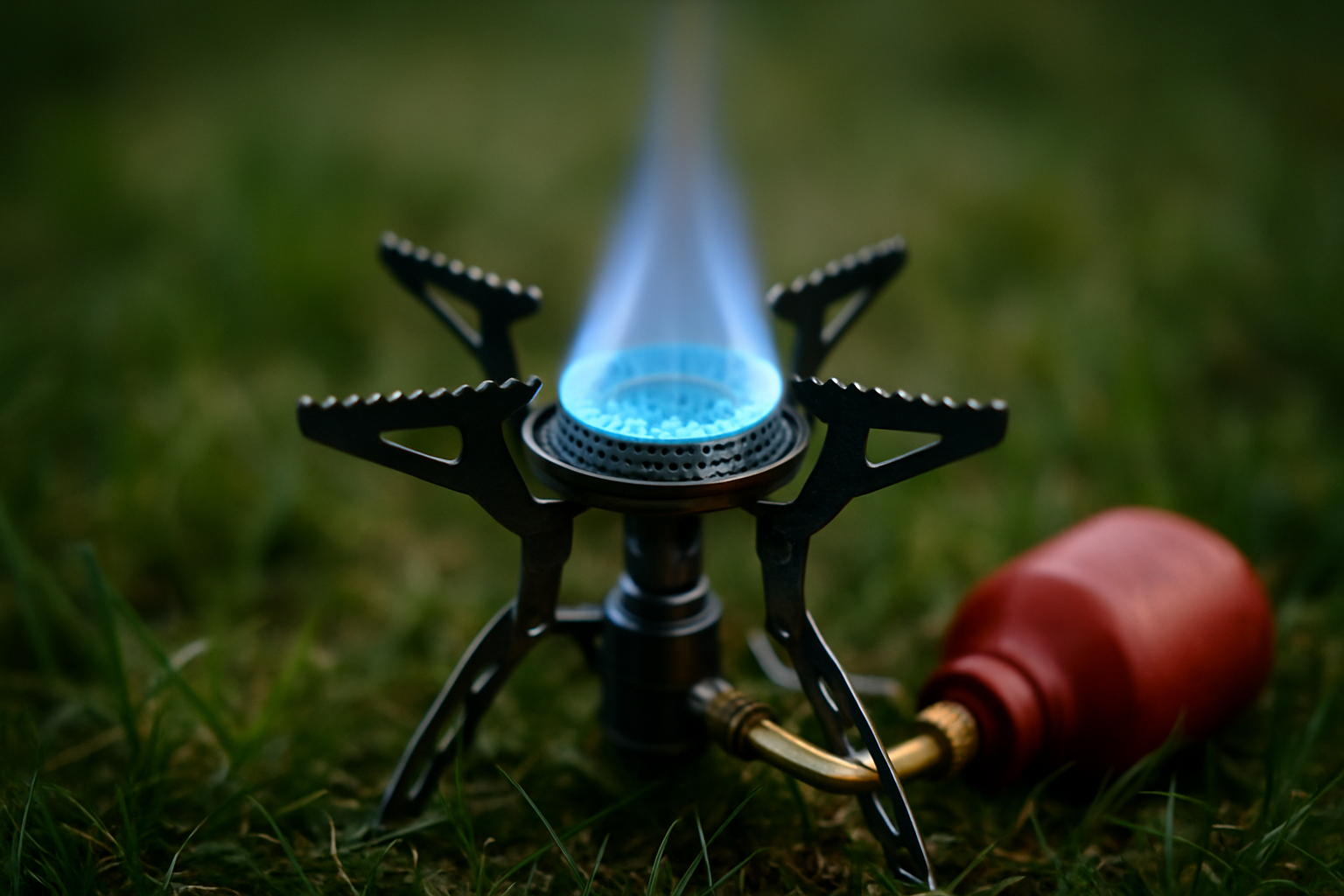
Picture a shoulder-season traverse where nights dip just below freezing and afternoons climb into comfortable hiking weather, and you want fast morning coffees, a hot dinner, and minimal fuss, so a regulated upright canister stove with an integrated pot and a small folding windscreen behind a rock can keep daily fuel around ten grams per liter while staying safe around the canister. Now imagine a four-day winter summit push with nightly lows near minus fifteen degrees Celsius and hours of snow melting, and the calculus flips toward white gas with a wide pot, a full-height windscreen, a pot lid that actually fits, and a tidy primer ritual that gets you roaring without flaring, which keeps fuel in the bottle and not in the air. For families cooking real meals at a windy coastal campsite, a stable two-burner camp stove with propane and a large, lidded pot makes simmering pasta and heating sauces efficient, since the big pot captures the flame pattern and wind blocks reduce convective loss, and you can clearly see how the right pairing makes dinner both faster and cheaper. Heatinerary’s Trip-Tuned Stove Lab turns those kinds of plans into tailored recommendations by considering your route profile, seasonal temperature bands, and cooking style to match a stove category, the best fuel for the temperature band, the pot geometry that captures your flame pattern, and the small accessories that prevent waste while keeping safety front and center.
Stove Fuel Efficiency: Best Practices You Can Trust
To make efficiency repeatable rather than lucky, anchor your system on three pillars that you can control in any weather: match fuel to temperature band and stove design, control the wind with smart positioning and safe shielding, and choose cookware that couples well with your burner while using lids and cozies to hold heat between flame spurts. Keep canisters warm in a jacket pocket before cooking, elevate them on an insulating pad in snow, and in true cold favor remote-canister inversion with a compatible stove or switch to white gas so pressure loss does not dictate your menu or morale, and remember that the safest windscreen is one that blocks gusts from the pot while leaving the fuel source cool and ventilated to the touch. Practice simmer technique at home with your real recipes, not just water boils, because pasta, rice, and sauces reward steady low heat rather than a roaring blue torch, and those minutes of crackling flame are where fuel goes to die; when you tune that flame lower and get the same food quality, you are literally walking away with grams saved every meal. When you combine these habits with planning tools and data from Heatinerary’s reviews and the Trip-Tuned Stove Lab, stove fuel efficiency becomes less of a hope and more of a predictable outcome that supports safe, enjoyable cooking wherever your route bends.
Safety Flags: Efficiency Without Compromise
Efficient does not mean risky, so resist the temptation to over-enclose stoves or canisters with windscreens that trap heat dangerously close to fuel sources, and always verify by touch that canisters and bottles remain cool, relocating screens or backing off if they warm beyond comfortable handling. Review essential precautions in our camp stove safety guide before your next cold-weather trip. Use stable, flat platforms for liquid-fuel stoves, prime carefully to avoid large yellow flares, keep flammable items like gloves and maps well away from the stove, and never use a stove in a closed shelter because carbon monoxide is both invisible and deadly, even when a flame looks clean and blue. Respect fuel handling by labeling bottles clearly, keeping white gas containers tightly sealed and away from sleeping areas, and wiping drips before ignition, because a clean setup saves fuel and prevents evaporation losses while keeping you safe. The goal is not only to boil faster or carry less but to ensure that your system works predictably in weather and terrain where you cannot call for takeout, and that is where a disciplined approach and trusted guidance from a resource like Heatinerary shine.
Your crash course promise is simple and powerful: match fuel, stove, and cookware to the real conditions and techniques that your trip demands, and you will unlock dependable performance with less weight and worry. In the next twelve months, expect more precise route-based recommendations, richer community boil logs, and forward-looking gear tests at Heatinerary that translate lab insights into practical field choices you can trust on windy ridge camps and snowed-in basins. What would it feel like to step onto your next route with a plan so dialed that stove fuel efficiency becomes just another thing that quietly works in the background while you focus on the view?
When that happens, you are not gambling on a blue flame in a white world but running a tested plan that saves grams, minutes, and stress, and that is the kind of stove fuel efficiency that pairs comfort with safety in any season.
Additional Resources
Explore these authoritative resources to dive deeper into stove fuel efficiency.
- How Much Stove Fuel Do I Need for a Backpacking Trip? - REI
- Stoves 101: How Much Fuel Should I Carry? – Cascade Designs
Fine-Tune Your Stove Setup With Heatinerary
Heatinerary’s Trip-Tuned Stove Lab gives campers, backpackers, and outdoor enthusiasts tailored stove, fuel, and cookware matches by route profile and season for efficient, safe cooking anywhere.

